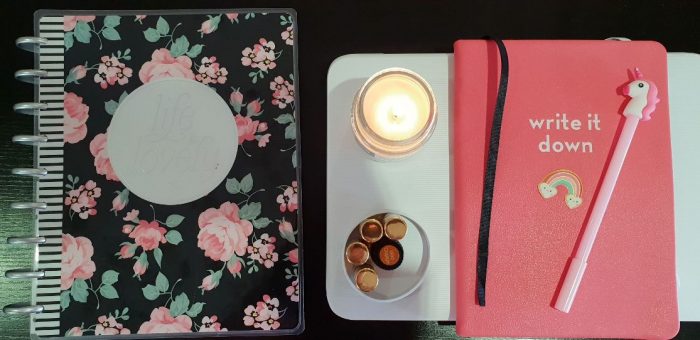Finding an unexpected lifesaver amidst a mindset journaling tribe.
A few weeks ago, I walked around the house checking furniture and sifting through the medication cabinet, trying to figure out the easiest way to end my life.
I had just received confirmation I was unlikely to work again due to my mental health challenges. This was not what I wanted for my life. I didn’t sign up for this. I couldn’t merely mooch off my husband like a burden forever.
Surely, this world was better off without me.
The negative voices, that “mean b*tch committee” in my head, told me my husband would move on and my son would find a “better” mum—one without anxiety and depression, who was normal and earned money. My boys would be far better off with me gone, they said.
This certainly isn’t the first time I’ve felt this depressed, but I do hope that it’s the last and I’m working on putting things in place to make sure it is.
I’ve worked in mental health and I know better than most that suicide is a prominent public health concern.
Australian crisis support and suicide prevention service Lifeline reported that in 2015, a staggering 3,027 deaths in the country were due to suicide. And on average, for every death by suicide, 30 people attempt to end their lives. Staggeringly, people ending their own lives prematurely remains the leading cause of death for Australians aged between 15 and 44. Public mental health resources are beyond stretched, and public adult psychiatric wards have too few beds and are woefully underfunded.
According to Mindframe, those most at risk of suicide are people who have made a previous attempt, those with mental illnesses (particularly when treatment has been reduced), and those with drug and alcohol problems. Sadly, people of Aboriginal and Torres Strait Islander descent are also at high risk. Males are around three times more likely to die by suicide than females.
Additionally, the Centre for Disease Control and Prevention which is a lead global body in public health based in the United States lists suicide factors as being family history of suicide, family history of child maltreatment, feelings of hopelessness, impulsive or aggressive tendencies, local epidemics of suicide, isolation, barriers to mental health treatment, loss (social, work, financial or relational), physical illness, easy access to methods, and unwillingness to seek help due to cultural and religious beliefs or mental state.
I fit at least four of those high-risk categories.
Knowing these statistics never stopped the way I felt, of course. It’s frustrating to think that from the time we are children, we are taught to work hard at school, get a good job, have money, buy a house, have a family, and be happy. No one ever says you could follow the steps and then have tragedy strike and not be happy.
Thankfully, on that very dark day some tiny little part of me took a chance on fighting for my life, and I called the Mental Health Triage number. They talked me through it, and I took a bed at a private psychiatric facility the following morning. Even there, I had “fight-or-flight” syndrome and still felt suicidal. I planned to leave the hospital and disappear.
My doctor talked me into staying, however, and seeking help and treatment to get myself better—if not for me, for my family.
I sat in my neat, private room surrounded by artwork, with murmurings of medication and lack of appetite from the corridor. We weren’t allowed televisions, only a laptop, so I registered for a mindset journaling course to pass the hours.
Day one of the course was tough.
My suicidal-self had to list 50 things I was grateful for (and believe me, being in a psychiatric ward was not one of them). And then I had to come up with a further 20 things I was grateful to myself for…that bit was really hard.
I did conclude by the end of the journaling prompt, though, that I was most grateful for private health insurance, safety on the unit, caring nurses, and to myself for reaching out to seek help.
By then, I’d felt a shift in my mood. My mindset wasn’t quite so dark. I saw a spark in myself—like it had been reignited. Maybe I was even a little bit “lucky?” I continued Susi Kaufer’s journaling mindset challenge for three days and by the third, I didn’t want to end my life anymore.
I realised that not only did I have things to be grateful for, there were affirmations I could pen. I had been tough and brave enough to seek help. I have an amazing son, so I must be a good mum. I’m not a victim—I’m a survivor, and although I can’t work, I have a small financial safety net for my bigger-vision stuff.
While I was journaling, I could speak freely without fear of judgement. I could say my “unspeakables” without fearing consequences, and I eventually got gutsy enough to spin those negatives back on their head. Irrespective of my circumstances, I could dream of a bigger and better future.
That was not something I’d ever been taught before. Never before had I felt that freedom—until now, there had always been consequences for honestly expressing myself.
My big vision for the future turned to how I might contribute to my family, instead of what a burden I’d be. I found myself goal setting, which increased my resilience, and the open dialogue through the cathartic practice of writing something down set me free. There is such a powerful value in dreaming about the future, having actionable plans, and being able to share these with others. The psychologist at the hospital advised me to talk to myself the way I would a friend in that situation, which lead to an enormous shift too.
This got me thinking:
Imagine if, in schools, we taught children less about mathematical theory and more about basic life skills like coping emotionally, celebrating milestones, positive psychology, affirmations, gratitude, and perhaps most importantly self-love (as well as tangible goal setting).
As a voice of lived experience, I wonder whether it may actually save lives?
Perhaps we are missing vital opportunities to change the dialogue for the next generation. The truth being, of course, that true happiness does not always come from material wealth or success.
There is satisfaction in being of benefit to others, but a sense of contentment can also come from within. We put so much emphasis on achievement, performance, and material wealth, and we sometimes forget that they don’t necessarily equate to satisfaction or happiness. Currency cannot be exchanged for happiness. There’s far more to being a good person than your rung on the ladder.
We should also be teaching that opening up about grief and sorrow is a natural part of the healing process, and that being a kind person and a good friend is arguably far more important than your current employment status or position.
And finally, but perhaps most importantly, we could let the next generation and each other know it’s okay to open up about not being okay, irrespective of circumstance.
These are all lessons I’ll be arming my son with moving forward (as well as a trusty journal for when he’s old enough to write). If you think it could help, perhaps you could do the same with your nearest and dearest.
As for me, I’m glad my furniture is no longer a potential implement of danger, but once again a place to sit in comfort. And finally, my medication is now merely a means to staying well, both for myself and two beautiful boys.
Now that I can see clearly (both in terms of mindset and perspective) and even if it starts at home with changing the dialogue and allowing freedom of expression for the mind, body, and soul…there really is so much to live for.
~









Read 0 comments and reply